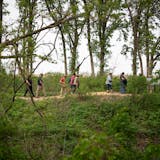A blaze leveled the large Camp Nenookaasi homeless encampment Thursday, sending billowing smoke over south Minneapolis as residents were forced to evacuate.
Camp leader Nicole Mason said she was at the site when she noticed a yurt was on fire. Several neighbors said they heard explosions amid the flames.
“I went to get an extinguisher and saw the fire was spreading from yurt to yurt, so I thought the first thing was to get everyone out,” Mason said.
A call came in a little after noon about the fire in the 1100 block of E. 28th Street, Fire Chief Bryan Tyner said at a news conference. Firefighters evacuated roughly 50 nearby residents and put out the blaze in about 30 minutes, the chief said.
An investigation into the cause of the fire was underway Thursday. Propane tanks could be seen scattered around the camp’s remains, and Tyner said the flammability of the site made for a “very dangerous situation.”
“What we saw today is kind of our worst fear when you have that situation,” Tyner said.
Two people suffered minor injuries, one with burned hands and another with smoke inhalation, Tyner said. Neither needed to be hospitalized.
At the news conference, Mayor Jacob Frey reiterated past statements that large homeless encampments aren’t safe for the people living there “and they’re not safe for the surrounding neighbors.”
![Three weeks ago, Octavio Rodriguez switched from making transmission parts to casting parts for hospital bed brake assemblies at Twin City Die Castings. ] GLEN STUBBE • glen.stubbe@startribune.com Thursday, April 9, 2020 How employee-owned Twin City Die Casting, which just laid off 40 production workers of its 250 employees in what was supposed to be a good year, is trying to accelerate its pivot to growing medical parts business for ventilators, hospital beds, etc as it copes with instan](https://arc.stimg.co/startribunemedia/WNZYKGTZ5IYMUCO3KI5TR3N7WI.jpg?&w=80&ar=1:1&fit=crop)
djoles@startribune.com As boaters flock to Minnesota lakes and rivers this holiday weekend for the unofficial kick-off to the boating season, they'll face more inspections in and out of the water as local cities and counties ramp up their work to stop the spread of invasive species. Across the metro, more boat accesses will be staffed by watercraft inspectors thanks to $10 million funneled to county government programs this year, up from $4.5 million the state allocated last year. ORG XMIT: MIN1505222156290209 ORG XMIT: MIN1506021218440580](https://arc.stimg.co/startribunemedia/34QSKO44B2XKVNUZCO5SLJQSLY.jpg?&w=80&ar=1:1&fit=crop)

